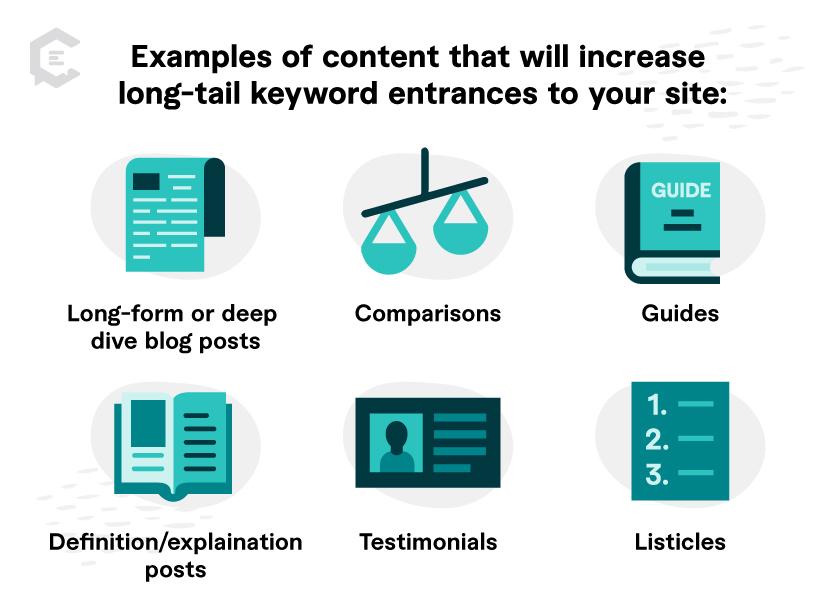What are long-tail keywords?
Long-tail keywords are phrases (usually three or more words) with lower monthly search volumes that are also highly relevant to a specific niche or audience. The term “long-tail” refers to a graph of competitiveness versus the conversion rate of keywords. For example:
- Short keyword: “shoes”
- Long-tail keyword: “best running shoes for flat feet”
Unlike short, more generic keywords, long-tail keywords are more detailed and specific. They reflect the searcher’s intent more precisely. Since they’re less competitive and more precise, it’s easier for your content to rank higher in search engine results for those specific queries. That increases the likelihood of showing up on that coveted first page on Google, which increases the chance of clicks and conversions.
Why are long-tail keywords important?
Incorporating long-tail keywords into your content marketing strategy aligns your content with the specific needs of your target audience. That leads to improved search engine visibility and increases the likelihood of conversion.
And long-tail keywords are even more crucial with the increasing popularity of voice-activated assistants like Siri and Alexa. Voice searches are typically longer and more conversational. That’s perfect for long-tail keyword phrases. Voice searching is also used a ton for local SEO (i.e., “What is the best pizza restaurant in New York City?”). By incorporating location-specific long-tail keywords, businesses can effectively target their local customers.
More content = more long-tail keywords
Long-tail keywords are great to have on your side. Sure, having a top-ranking, highly competitive keyword is great, but so is having a long list of long-tail keywords with higher conversion rates.
To increase your number of long-tail keyword rankings, there’s just one thing you have to do: Publish more great content.
Examples of content that will increase long-tail keyword entrances to your site:
- Long-form or deep-dive blog posts
- Definition/explanation posts
- Guides
- Comparisons
- Testimonials
- Listicles
How to find long-tail keywords
It can be harder to find long-tail keywords since they have less search volume and won’t be as prominent. Here are a few ways to perform long-tail keyword research that will identify some awesome opportunities for your content.
1. Use Answer the Public
Answer the Public is a tool that generates long-tail keyword ideas based on what people are searching for via Google. A quick search for “content marketing” brings up a gold mine of long-tail ideas.
2. Go down a Google rabbit hole
Start typing a core keyword into Google and let it autocomplete some words for you. Try typing in “content marketing” and see what happens if you begin another word with “g.” The first word that popped up for me was “goals.”
After choosing “goals” in the autocomplete list, we now have a “people also ask” box with even more ideas. As you click on those questions to see the results, more questions will keep appearing, taking you further down the rabbit hole.
3. Spend time on forums
Sometimes people struggle to find the hyper-specific answer they need on search engines. So, they turn to their internet community. Forums are hubs of users offering authentic, personal solutions to each other’s questions. They’re a fantastic place to hunt for long-term keywords.
If you’re struggling to find the forums where your target audience is hanging out, there’s an easy way to use search engines to locate them. Head to a search engine with a basic keyword in mind and type:
- “keyword” + “forum”
- “keyword” + “board”
- “keyword” + “powered by vbulletin”
4. Use your customer service records
Whatever your product or service, you’ll inevitably get questions from prospective and current customers. Keep a record of the questions they ask. You might want to answer them with content on your website.
Prospective customers are an especially great resource. They are a window into what other potential customers might be typing into their search. Chances are, their questions are long-tail keywords that you can rank for and grab traffic from.
Long-tail keyword examples
Somebody landing on a site after searching for “T-shirts” is probably just browsing. They haven’t decided exactly what kind of shirt they want.
However, someone landing on a site after searching “Blue American apparel T-shirts” is likelier to buy the shirt (convert).
It’s a little more complex if you sell services rather than products, but you can still apply the same principle. For instance, a person searching for “content marketing” will likely do some beginning research and click around on different results.
In contrast, someone searching for “content marketing for construction companies” gets more specific. That means more specific results. If you’re a content marketing company with a great long-form blog post on content marketing for construction companies, you have a good chance of making that connection and conversion.

The more content you create that ranks highly for long-term keywords, the easier it will be for customers to find you. Start with researching key phrases in your industry. Explore what your current customers want to know, and then create specialized content to match those long-term keyword needs.
If you want to create high-quality content that engages readers and ranks higher in search engines, we’re here to help. Talk to a content specialist at ClearVoice today to elevate your strategy to the next level.





